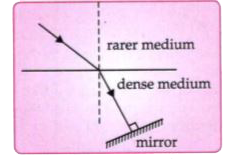When a ray of light travels obliquely from a rarer medium to a denser medium, it bends away from the normal.
To determine whether the statement "When a ray of light travels obliquely from a rarer medium to a denser medium, it bends away from the normal" is true or false, we can analyze the behavior of light during refraction.
1. Understanding Refraction:
- Refraction is the bending of light as it passes from one medium to another. This occurs due to a change in the speed of light in different media.
2. Identifying the Media:
- In this case, we have two media: a rarer medium (like air) and a denser medium (like water or glass). The rarer medium has a lower optical density compared to the denser medium.
3. Direction of Light Ray:
- When a ray of light travels from the rarer medium to the denser medium, it does so at an angle to the normal (the imaginary line perpendicular to the surface at the point of incidence).
4. Behavior of Light:
- As the light ray enters the denser medium, its speed decreases. According to the laws of refraction (Snell's Law), when light moves from a medium of lower optical density to a medium of higher optical density, it bends towards the normal.
5. Conclusion:
- Therefore, the statement that the ray of light bends away from the normal is incorrect. Instead, the ray of light bends towards the normal when moving from a rarer medium to a denser medium.
Final Answer:
The statement is false. When a ray of light travels obliquely from a rarer medium to a denser medium, it bends towards the normal.
---
- Refraction is the bending of light as it passes from one medium to another. This occurs due to a change in the speed of light in different media.
- In this case, we have two media: a rarer medium (like air) and a denser medium (like water or glass). The rarer medium has a lower optical density compared to the denser medium.
- When a ray of light travels from the rarer medium to the denser medium, it does so at an angle to the normal (the imaginary line perpendicular to the surface at the point of incidence).
- As the light ray enters the denser medium, its speed decreases. According to the laws of refraction (Snell's Law), when light moves from a medium of lower optical density to a medium of higher optical density, it bends towards the normal.
- Therefore, the statement that the ray of light bends away from the normal is incorrect. Instead, the ray of light bends towards the normal when moving from a rarer medium to a denser medium.
The statement is false. When a ray of light travels obliquely from a rarer medium to a denser medium, it bends towards the normal.
Similar Questions
(a) State Snell's law of refraction of light.
(b) A transparent medium A floats on another transparent medium B. When a ray of light travels obliquely from A into B, the refracted ray bends away from from the normal. Which of these two media A or B are optically denser and why ?
View SolutionA ray of light travelling obliquely from glass to air :
View Solution
Knowledge Check
When a light ray enters from a denser medium to a rarer medium.
AThe light ray bends towards the normal.BAngle of incidence is less than angle of refraction.CSpeed of light decreases.DSpeed of light remains unchanged.When a ray of light from air enters a denser medium, it :
Abends away from the normalBbends towards the normalCgoes undeviatedDis reflected back
When a light ray from a rarer medium is refracted into a denser medium, its
View SolutionWhen a ray of light travels from optically denser medium to optically rarer medium, it always bends towards the normal.
View SolutionAssertion A ray of light travels from first medium to second medium. In first medium, angle of ray with normal is i1=30∘ and in second medium i2 = 60∘ Then, second medium is rarer medium.
View SolutionWhen a ray of light travels from an optically less denser medium to an optically more denser medium, the angle of incidence is always less than angle of refraction.
View SolutionWhen a ray of light travles from an optically more denser medium to an optically less denser medium, the angle of incidence is always _____ than the angle of refraction.
View SolutionA ray of light is moving from a rarer medium to a denser medium and strikes a plane mirror placed at 90∘ to the direction of the ray as shown in the diagram.

Name the principle you have used to mark the arrows to show the direction of the ray.
View Solution
